A Feast of Flowers in the Picos de Europa - Trip Report - June 2009
Teresa Farino
04/12/2009 11:55:53
Written by Caroline Bateman and illustrated by Teresa Farino, this report gives highlights of IWT's most recent botanical tour in the Picos de Europa, during which we also encountered a wealth of other wildlife.
Posted in: Flora, Butterflies and Moths, Amphibians, Reptiles, Birds, Mammals | Asturias, Cantabria, Castile-Leon | Mainland Spain, Northern Spain
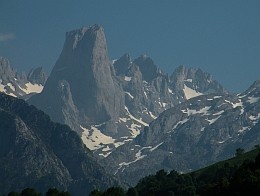 Naranjo de Bulnes© Teresa FarinoThis was the fourth such trip that Teresa has led in the Picos de Europa. Although flowers were the primary focus, we also saw a fabulous selection of birds, reptiles, amphibians, butterflies, moths and other sundry creatures during the week, plus a magnificent Wildcat.
Naranjo de Bulnes© Teresa FarinoThis was the fourth such trip that Teresa has led in the Picos de Europa. Although flowers were the primary focus, we also saw a fabulous selection of birds, reptiles, amphibians, butterflies, moths and other sundry creatures during the week, plus a magnificent Wildcat.
Tuesday, 2 June: Asturias – Pesaguero
The seven of us who flew in from Stansted (Martin, Lesley, Linda, Alan, Helen, Richard and Caroline) managed to find each other and Teresa at the airport in Asturias. It was a three-hour journey to Pesaguero but it didn’t seem that long, with lots of interest on the way. Teresa drew our attention to the eucalyptus plantations, used for the manufacture of paper pulp, which have replaced much of the natural deciduous forest along the coastal strip of northern Spain. A refreshments stop at Alto de las Estazadas also gave us the opportunity to explore a nearby verge, where we saw our first Heart-flowered Serapias, Bee Orchids, Scrambling Gromwell and the pink form of Kidney Vetch.
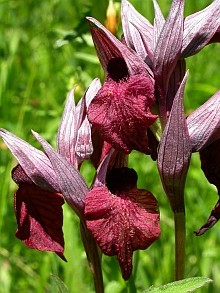 Heart-flowered Serapias
Heart-flowered Serapias
Serapias cordigera© Teresa Farino
We stopped to admire the distinctive limestone peak of Naranjo de Bulnes, and then followed the N621 through the long, winding Desfiladero de La Hermida, carved out by the river Deva. This spectacular gorge is so deep and narrow that no direct sunlight reaches the village of La Hermida for five months of the year.
We eventually arrived at Posada El Hoyal where we were joined by John, who had driven up from Portugal. Óscar served us the first of many good meals, prepared by Carmen from fresh local ingredients, and we had our first taste of tea infused from Hyssop-leaved Sideritis, served with a slug of orujo (grappa). (During the week, Helen and Linda were to try every version of orujo stocked in the bar!)
Wednesday, 3 June: Fuente Dé
We woke to blue skies, the sound of the Cuckoo and a well-populated moth trap, with highlights including the dinky little Garlic Mottled, plus Lime, Elephant and Small Elephant Hawkmoths, Green Silver-lines and The Alchymist. However, a poor weather forecast for the days ahead persuaded Teresa that we should not follow the planned itinerary, instead making the most of good visibility to visit the alpine rock gardens above Fuente Dé.
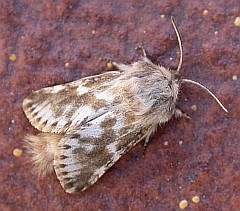 Garlic Mottled
Garlic Mottled
Dyspessa ulula© Teresa FarinoThe cable-car ascent from 1094 m to 1847 m (2625 feet!) in just three and a half minutes was impressive, but the view of the Cordillera Cantábrica from the Mirador El Cable was simply spectacular. After much photography and substantial applications of sun lotion, we picked our way across the rocky terrain, admiring the gorgeous blue Trumpet and Spring Gentians. Dotted everywhere were tiny trumpets of Narcissus asturiensis, interspersed with Amplexicaule Buttercups, Cone Saxifrage and the beautiful, blue-tinged Anemone pavoniana, all endemic to the Cordillera Cantábrica and Pyrenees. In profusion were Spanish Broom and another local endemic, the spiky Genista legionensis, a.k.a. ‘Mother-in-law’s Cushion’.
We stooped to examine exquisite little blooms of Chamois-cress, the rock-jasmine Androsace villosa, Prostrate Toadflax, Hepatica, Leafless-stemmed Globularia and another endemic of the Cordillera Cantabrica, the pinkish crucifer Matthiola perennis. Crevices in the limestone pavement sheltered Holly Fern, Brittle Bladder Fern and both Maidenhair and Green Spleenworts. Some Painted Ladies and Clouded Yellows fluttered by, and the photographers spent quite some time on their hands and knees trying to capture the lovely yellow Eurranthis plummistaria moths on film, while our first Griffon Vultures cruised overhead.
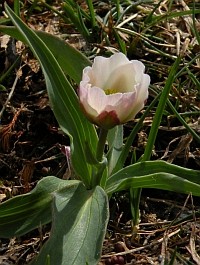 Amplexicaule Buttercup
Amplexicaule Buttercup
Ranunculus amplexicaulis© Teresa FarinoThe crystal-clear water of a small pool offered us a good view of the resident Alpine Newts, while some Isard (Southern Chamois) posed for us against the snow. We had been hoping to watch Wallcreepers while we had lunch but, after a hard winter, the snow had not yet retreated far enough for us to see them in their usual haunt at the base of the towering buttresses of Peña Vieja. We were entertained instead by the antics of Alpine Choughs, who were extremely interested in our rather good picnic, and by the sight of a couple of Guardia Civil patrolling their beat on skis. During the morning our bird tally also included Red-billed Chough, Alpine Accentor, Water Pipit, Northern Wheatear and Black Redstart. Eventually, and with much joy, the elusive Wallcreeper was also spotted (by those equipped with binoculars, anyway!).
Before returning to the cable-car station, those of us who still had the energy for another descent, and the inevitable return uphill, followed the winding trail down towards the Chalet Real. On springy turf above this former royal hunting lodge we found Spring Pasque-flower, mainly fruiting but with the odd flower still remaining; cushions of Moss Campion just coming into flower; vivid blue Alpine Forget-me-not; Mountain Everlasting; Meadow Saxifrage; and the sheep’s-bit Jasione crispa.
Thursday, 4 June: Piedrasluengas
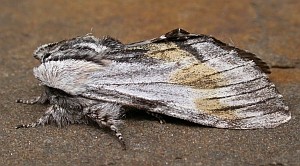 Tawny Prominent
Tawny Prominent
Harpyia milhauseri© Teresa FarinoShortly after dawn, we once more examined the contents of the moth trap, which on this occasion turned up such photogenic beasties as Lobster Moth, Tawny, Pebble, Three-humped and Swallow Prominents, Lesser Puss Moth, Cream-spot Tiger, Watsonarctia casta (for an image of this distinctive Arctiid click here ) and Peach Blossom, as well as a new species for Teresa’s Picos list: Indistinct Marbled Brown (Drymonia obliterata).
After breakfast, dodging the poor weather, we made our way south-east to the Puerto de Piedrasluengas, just inside Castilla y León. At 1329 m we were well above the low-lying cloud and, in sunshine, we watched a herd of the local breed of long-horned cows (casinas) arrive at its summer pasture. A semi-circular route took us through a range of habitats: sloping subalpine grassland, limestone outcrops, a shrubby “heath”, shaly banks and wet meadows.
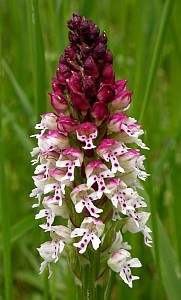 Burnt Orchid
Burnt Orchid
Orchis ustulata© Teresa FarinoIn the lower pastures, and in no time at all, we recorded seven species of orchid: Green-winged, Early Purple, Burnt, Early Marsh, Heath Spotted, Lizard and Early Spider. On higher pasture and rock outcrops, we found the pretty local endemics Violet Mountain Pansy and the woodruff Asperula hirta, as well as British rarities such as Malling Toadflax, Round-headed Leek, Spignel, Stinking Hellebore and the once-common arable weed Corn Chamomile. Also abundant were huge cushions of Saxifraga canaliculata, unique to this region, as well as other species of limestone rock-gardens such as Livelong Saxifrage, Globularia repens and the fleshy-leaved houseleek Sempervivum vicentei, the latter sadly not yet in flower.
Around us we could hear and see Quail, Wood Lark, Rock Bunting, Linnet, White Wagtail, Yellowhammer, Corn Bunting and, eventually, Rock Thrush. Berger’s Clouded Yellow, Oberthür’s Grizzled Skipper and de Prunner’s Ringlet fluttered by, while a Glanville Fritillary posed photogenically on Proliferous Pink.
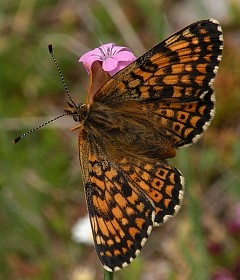 Glanville Fritillary
Glanville Fritillary
Melitaea cinxia© Teresa FarinoMaking our way back down we came through a shrubby zone of Spanish Heath, Tree Heath and Halimium umbellatum. On a shaly bank a glorious blue patch turned out to be the aptly named Beautiful Flax, while nearby a basking Slow-worm didn’t want to have its photo taken. Almost back at the level of the road we made our way through a damp meadow studded with Ragged Robin, Marsh Marigold, Bistort and Early Marsh Orchids galore.
After a splendid lunch (using a bus shelter as our refectory and with a splendid view of a stork’s nest on a pylon), we made our way towards a limestone gorge just south of the pass. We came to a quick halt when Helen’s sharp eyes spotted a Wildcat, looking rather like a domestic tabby but much larger, and with a bushier black-ringed tail ending in a black point. It considered us warily before disappearing into the beech hanger (to re-emerge later in its hunting ground in the open pasture, where some of us managed to get some long-distance photos.
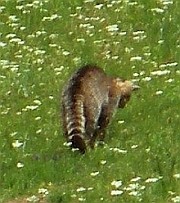 Wildcat
Wildcat
Felis sylvestris© Teresa FarinoIn the woodland fringes we recorded, inter alia, Bird Cherry, Fly Honeysuckle, Green Hellebore, Aconitum lamarckii, Aconite-leaved buttercup and Pyrenean Squill; on the roadside were Pyrenean Valerian, and Gouan’s buttercup; and in the damp meadows beside the stream were Water Avens and the beautiful daffodil Narcissus pseudonarcissus ssp. nobilis. Pale-flowered Orchid was added to our tally of orchids, and Orange Tip and Duke of Burgundy Fritillary to our list of butterflies.
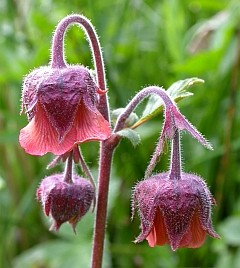 Water Avens
Water Avens
Geum rivale© Teresa FarinoWe ended the excursion on an ornithological note, admiring White Storks in their enormous nests near the Embalse de Requejada, and once back at the hotel we celebrated Martin’s birthday with drinks at the bar and a birthday cake.
Friday, 5 June: Sierra de Beges
We parked at Puente La Llambre, just below Beges, as a landslide earlier in the year had blocked the road for vehicles. This added a kilometre or so to our walk to the meadows above the village but enabled us to appreciate the clusters of red-roofed houses and to see some more Alpine Newts in a water trough in the village.
The concrete track we were to follow rose above us in a series of hairpin bends. Progress was slow, not just because of the gradient, but also because of the masses of flowers in the terraces on either side of the track, including the familiar garden perennial Astrantia, Greater Yellow Rattle, Spreading Bellflower, Pyrenean Eryngo, Pyrenean Germander, Bloody Crane’s-bill, Pyrenean Hawk’s-beard and Columbine.
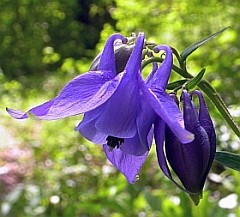 Columbine
Columbine
Aquilegia vulgaris© Teresa FarinoLess flamboyant but equally pleasing were little gems like Fairy Foxglove, Bitter Vetch and Little Robin. Cornish Heath, a lime tolerant heather, was abundant. Countless Man Orchids, some knee high, lined the track and by the time we had reached the top, we’d seen several more orchids: Woodcock Orchid, Fly Orchid, Provence Orchid and Fragrant Orchid, as well as a brood of young Blackcaps perched on a fence.
Despite the rain, which had started to fall in sheets, the best was yet to come. Making our way through sodden grass studded with Heath Spotted-Orchids and then through dripping Sessile Oak woodland, we emerged into a sloping meadow, the sight of which took our breath away: Burnt and Fragrant Orchids, Heart-flowered Serapias, Columbine, Scrambling Gromwell, Pyrenean Eryngo, Eyebright, Milkwort and, the jewels in the crown: Pink Butterfly Orchid and the almost-black pasque-flower Pulsatilla rubra ssp. hispanica – Linda’s wish had been granted!
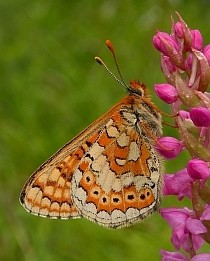 Marsh Fritillary
Marsh Fritillary
Euphydryas aurinia© Teresa FarinoFor a brief while, the rain stopped, the sun came out, the peaks of the mountains reappeared, and butterflies took to the air, including a Marsh Fritillary, which perched obligingly on a Fragrant Orchid to be photographed. We reluctantly tore ourselves away when the rain started to come down again, this time accompanied by lightning and loud claps of thunder (some at a count of two after the lightning!). We made our way back down the way we had come, some of us soaked to the skin, but still enthusiastic enough to stop and look at a Fire Salamander, unfortunately deceased, and to record the Giant Orchid that we’d missed on the way up. We finished the day having our picnic in a bar in La Hermida, whose hospitable owner had been forewarned by Teresa that a party of wet and bedraggled people was about to descend on his establishment.
Saturday, 6 June: Puerto de San Glorio
It was a chilly but stimulating start to the day. First there was a drive up through a tortuous section of the N621, accompanied by stunning panoramic views of the Cordillera Cantábrica. Then we were treated to another wonderful display of flowers in the wet, acid meadows just below the Puerto de San Glorio. The highlights were Horned Pansy and hundreds of orchids, including the vanilla orchid Nigritella gabasiana, Elder-flowered Orchid and Frog Orchid, but we were also very taken with the attractive Whorled Lousewort and its relative, the Iberian endemic Pedicularis mixta.
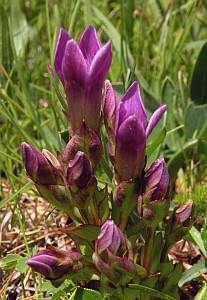 Field Gentian
Field Gentian
Gentianella campestris© Teresa FarinoWhite Asphodel, Globeflower and Viper’s-bugloss were in profusion, as well less eye-catching species like Cruciata glabra and Pyrenean Bastard-toadflax. A steep shaly bank was host to a range of acidophiles, including the broom Cytisus cantabricus and St Dabeoc’s Heath. In an adjacent meadow we were impressed by Carduus argemone, Spiked Rampion (the slate-blue form), Large Selfheal and Field Gentian. Once it had warmed up a bit, a few butterflies appeared, including a couple of new species for the week: Mazarine Blue and Provençal Fritillary.
A quick detour to the Monumento del Oso provided us with wonderful panoramic views over the massifs of the Picos, but as rain was threatening, we descended a few contour lines for our usual gastronomic lunchtime treat. Fortified, and in sunshine, we made our way up another steep meadow. This time, to Alan’s great pleasure, butterflies stole the show, including Black-veined White, Clouded Yellow, Small, Adonis and Black-Eyed Blues, Weaver’s, Marsh, Provençal, Silver-washed and Small Pearl-bordered Fritillaries, Spanish Swallowtail, Large Skipper and Marbled White.
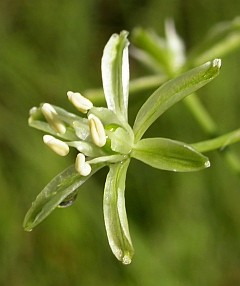 Bath Asparagus
Bath Asparagus
Ornithogalum pyrenaicum© Teresa FarinoThe flora was rich and varied too, with new records for us including Spotted Rock-rose, and in wet flushes, Brookweed, Bog Pimpernel and Broad-leaved Cotton grass. We examined the furry leaves of Pyrenean Oak and, not for the first time, commented on the wide (and from a British perspective, incongruous) range of plants in just one habitat.
Sunday, 7 June: Espinama
We’d all been looking forward to this trip to the orchid-rich habitats around Espinama, which was to exceed our highest expectations. Our circuit took us along a footpath with rich verges, through rock gardens, hay-meadows and deciduous woodland, with such an abundant and varied flora in each habitat that a complete account would take many pages. Starting off up the footpath we recorded, inter alia, Nottingham Catchfly, Perennial Yellow Woundwort, Rampion Bellflower, Musk Thistle, familiar to us all but not in the white form encountered here, Bath Asparagus and the splendid local endemic, English Iris. Two attractive moths were identified as a Yellow Shell and a Black-veined Moth, the latter a great rarity in Britain.
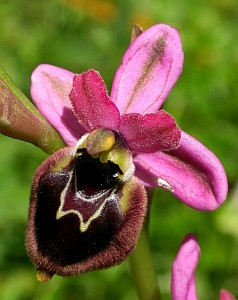 Hybrid Sawfly-Early Spider Ophrys
Hybrid Sawfly-Early Spider Ophrys
Ophrys tenthredinifera x sphegodes© Teresa FarinoLeaving the footpath and picking our way carefully across a flower-studded hay-meadow we saw our first spikes of Tassel Hyacinth, Pyramidal Orchid, Early Spider Orchid and Sawfly Orchid, plus the hybrid between these latter two species, with intermediate characteristics. On a path through Beech woodland there were several good spikes of White Helleborine as well as Herb Paris, Wild Liquorice, the attractive umbellifer known as Broad-leaved Sermountain and Martagon Lily, the latter unfortunately still in bud.
Emerging into a sunny rock garden, a Tree Pipit was spotted (and photographed) and butterflies began to appear: Adonis and Silver-studded Blues, Small Tortoiseshell, Red Admiral and Large Wall Brown, as well as another day-flying moth, Feathered Footman. We searched in vain for some Dense-flowered Orchids still in flower but instead found many other species characteristic of dry limestone grassland, including Pyrenean Flax, Sticky Flax, Round-headed Rampion, Squinancywort, the umbellifer Ligusticum lucidum ssp. lucidum, the tiny Dwarf Sedge and some splendid spikes of Lizard Orchid in full flower.
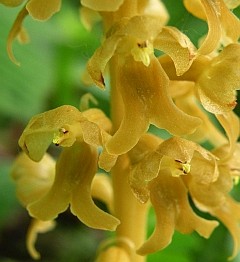 Bird's-nest Orchid
Bird's-nest Orchid
Neottia nidus-avis© Teresa FarinoWe relaxed and had lunch in a glorious spot overlooking a rich and highly colourful meadow. Doing our best not to flatten the hay crop, we then made our way down the steep slopes studded with vivid Maiden Pink and Rock Cinquefoil. In the flushes were Grass of Parnassus, the familiar Marsh Thistle, Marsh Ragwort and Marsh Hawk’s-beard as well as masses of orchids. Unfortunately, Barton’s Orchid had gone over, but we did see the hybrid between Early Marsh and Heath Spotted Orchid in a wet flush, and in dense shade under Beech we found Bird’s-nest Orchid and Twayblade. On the downward track to the minibus another new moth – Latticed Heath – was recorded.
On the Wednesday, there had not been enough time to examine the pastures and scree at Fuente Dé, so we drove the few kilometres to the car park at the lower cable-car station. A few people decided to call it a day and savour the superb view over a drink, but the rest of us made our way across the pastures, where cows and horses were grazing (both destined for the dining room table!).
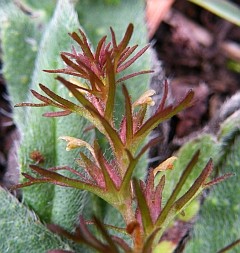 Triphysaria pusilla© Teresa FarinoThere was much of interest in this peaceful amphitheatre beneath the towering buttresses of the central massif: Wallflower Cabbage, Buckler Mustard, the candytuft Iberis carnosa, Pyrenean Mignonette, Pyrenean Vetch, the sweet-smelling spurge Euphorbia flavicoma, and the beautiful pale-lemon-flowered snapdragon Antirrhinum braun-blanquetii. Two more orchids were added to our list - Dull Ophrys and Common Spotted Orchid - and for the first time we saw fresh Hyssop-leaved Sideritis, rather than dried flowers infused in a tea-pot! Worthy of note was the diminutive yellow-flowered Triphysaria pusilla, a western North American species first recorded in Europe on one of Teresa’s tours in 2004, but not seen since. To finish the day we found some rather cute baby Fire Salamanders in a water trough.
Triphysaria pusilla© Teresa FarinoThere was much of interest in this peaceful amphitheatre beneath the towering buttresses of the central massif: Wallflower Cabbage, Buckler Mustard, the candytuft Iberis carnosa, Pyrenean Mignonette, Pyrenean Vetch, the sweet-smelling spurge Euphorbia flavicoma, and the beautiful pale-lemon-flowered snapdragon Antirrhinum braun-blanquetii. Two more orchids were added to our list - Dull Ophrys and Common Spotted Orchid - and for the first time we saw fresh Hyssop-leaved Sideritis, rather than dried flowers infused in a tea-pot! Worthy of note was the diminutive yellow-flowered Triphysaria pusilla, a western North American species first recorded in Europe on one of Teresa’s tours in 2004, but not seen since. To finish the day we found some rather cute baby Fire Salamanders in a water trough.
Monday, 8 June: Potes, Lebeña and Tudes
After a brief visit to Potes to have a look round the market, we headed north to the dry, acid region around Lebeña, in a sheltered valley to the east of the Desfiladero de La Hermida. The change of habitat presented us with a completely different range of species, with a distinct Mediterranean feel: Pitch Trefoil, Fennel, Round-headed Thyme, Daisy-leafed Toadflax, Galactites, Butcher’s Broom and Common Smilax, the latter two rather unlikely members of the Lily family.
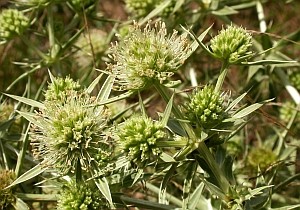 Field Eryngo
Field Eryngo
Eryngium campestre© Teresa FarinoIt didn’t take us long to find Red Helleborine, but it was rather late in the season for Sword-leaved Helleborine and Violet Limodore, both of which were in fruit. We compared two species of Sedum, Short-leaved Stonecrop and White Stonecrop, and took pleasure in seeing some more plants that are now extremely uncommon in Britain: Field Eryngo, Wall Germander and Weasel’s-snout. A Griffon Vulture circled above us and butterflies on the wing included Swallowtail, Berger’s Clouded Yellow, the female helice form of Clouded Yellow, Provençal Fritillary and a female Adonis Blue of the form ceronus, its distinctive orange lunules contrasting vividly with the blue upper-wings.
Sooty Copper and Speckled Wood were added to the list when we pulled over at the side of the road on the way up to Tudes, where we also saw St Lucie’s Cherry, Sad Stock, Vine and some splendid Lizard orchids about a metre high. It was here too that we spotted a Red-backed Shrike swooping down for insects, thus providing Martin with his best moment of the week. Initially we thought it might have been injured but then it provided us with a good view by perching in a bush right in front of us.
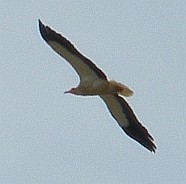 Egyptian Vulture
Egyptian Vulture
Neophron percnopterus© Teresa FarinoBy the time we reached the picturesque village of Tudes it was time for lunch, which we set out under a grove of enormous walnut trees, and during which entertainment was provided by a rooster with exquisite manners who made sure that his harem of scrawny hens got first pickings. Before we set off on the descent to Valmeo, we called by to see ‘Marvin’ the Marbled Newt, a resident of the water trough just below the village. He was duly admired by all, as was an Egyptian Vulture circling overhead.
The theory that all pink flowers smell was tested on some splendid Etruscan Honeysuckle and found to be true (in this case anyway!). Several more butterflies were added to the day’s list: Small, Large and Mallow Skippers, Marbled White, Meadow Brown and Wall Brown. It transpired that a rather inert bee had been seized from below by a Crab Spider (Synaema globosum), and an Iberian Wall Lizard posed to have his photo taken.
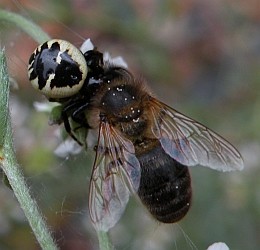 Female Synaema globosum© Teresa FarinoBotanically, there were some interesting new species for us to see too: Rock Soapwort, the graceful greenweed Genista florida, Andryala, Phagnalon saxatile and the viper’s-grass Scorzonera graminifolia, as well as some more vulnerable British species, namely Red Star Thistle and Deptford Pink. We also compared two species of Cistus: C. psilosepalus, with very ciliate sepals, and C. salviifolius with auriculate sepals.
Female Synaema globosum© Teresa FarinoBotanically, there were some interesting new species for us to see too: Rock Soapwort, the graceful greenweed Genista florida, Andryala, Phagnalon saxatile and the viper’s-grass Scorzonera graminifolia, as well as some more vulnerable British species, namely Red Star Thistle and Deptford Pink. We also compared two species of Cistus: C. psilosepalus, with very ciliate sepals, and C. salviifolius with auriculate sepals.
Our route down to the road took us through dry evergreen forest (mostly Western Holm Oak, but with a few Cork Oaks mixed in) and we felt as though we were in the Mediterranean region proper, with so much Turpentine Tree and Strawberry-tree around. A hand-grenade-shaped flower turned out to be Cone Knapweed, and Helen’s interesting grass was Aegilops ventricosa, a wild ancestor of wheat. While Teresa returned by taxi to Tudes to pick up the minibus, the rest of us looked round the village of Valmeo with its lovely old houses, some with their own colmenares (beehives).
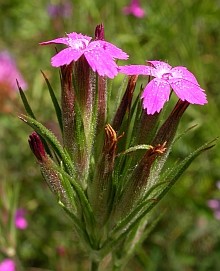 Deptford Pink
Deptford Pink
Dianthus armeria© Teresa FarinoTuesday, 10 June: Bufones de Arenillas – Asturias Airport
We said our farewells to John, who was spending a few more days in the area, and to Óscar and Carmen for looking after us so well (although John possibly had less to thank Óscar for than the rest of us, with a large dent in the back of his car as a souvenir of his stay at El Hoyal!).
There was just enough time for a brief stop for coffee at a roadside bar and a quick visit to the Bufones de Arenillas, where we saw the largest blowhole on the coast of Asturias. We didn’t see any 40 foot high spurts of water but we did hear loud groans as we tentatively approached its entrance. The area also provided an opportunity for some last-minute botanising and bird-watching. Sea Campion, Sea Plantain, Thrift, Sea Lavender and Black Bog-rush were abundant on the cliff tops and the slugs had changed colour from glossy black to dark brown, but were not quite as large as the monstrous versions we saw (or tried not to see!) in the Picos de Europa.
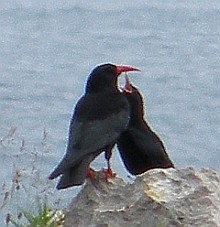 Red-billed Choughs
Red-billed Choughs
Pyrrhocorax pyrrhocorax© Teresa FarinoRed-billed Choughs feeding their young were observed on the cliffs, while Corn Bunting, Melodious Warbler (being chased by a butterfly!), Swallows and a Green Woodpecker were also spotted, the latter on the wall of a small cemetery. And we finished our botanising as we had started the week, with Heart-flowered Serapias on the verge of the track.
Many thanks to Helen Baker, Caroline Bateman, John Collier, Lesley and Martin Pallett, Linda and Alan Woodward and Richard Young for being such enthusiastic and knowledgeable companions during the week, and to Linda and Steve Petty and Sharon and Vernon Taylor for bringing their additional experience and sense of humour to some of our daily forays.
If you would like to find out more about Teresa's Feast of Flowers trips, please click here.
Related Information:
This year's Feast of Flowers tour runs from 5 - 12 June 2010
Details of all Teresa's wildlife holidays in 2010
A report from the Botanical Society of the British Isles Picos de Europa excursion in 2004
Read more blog posts